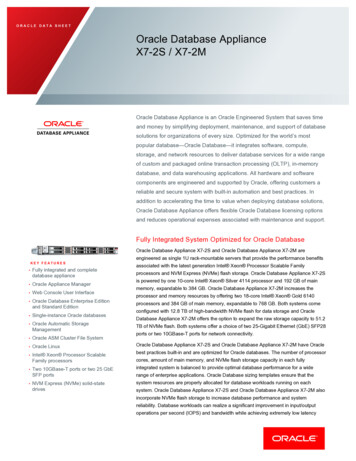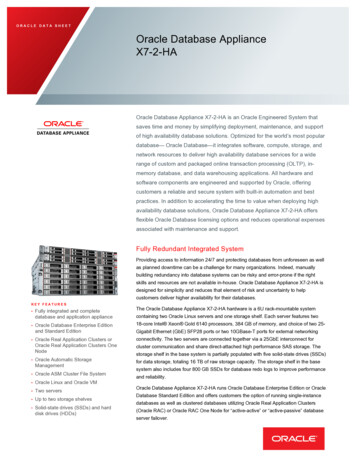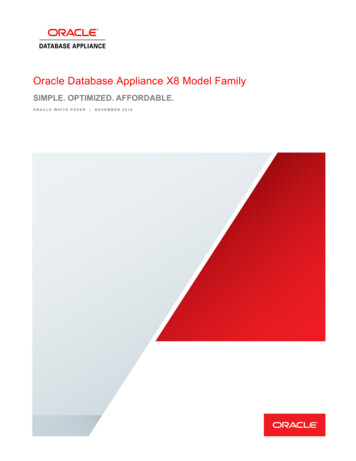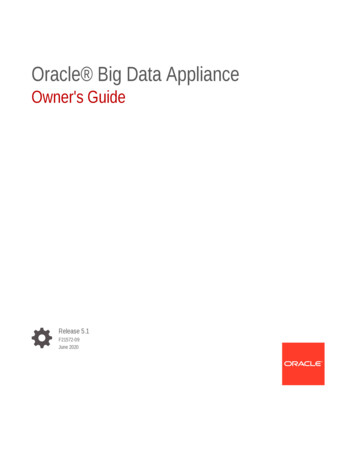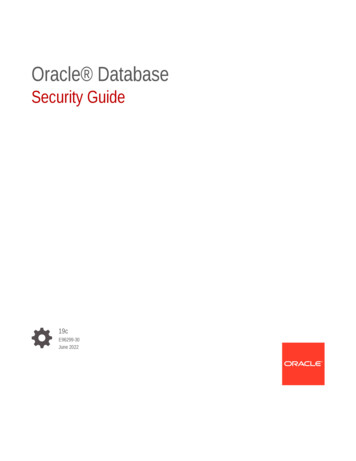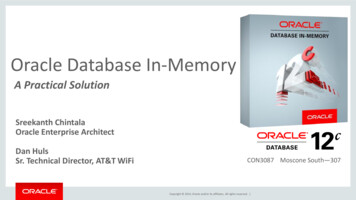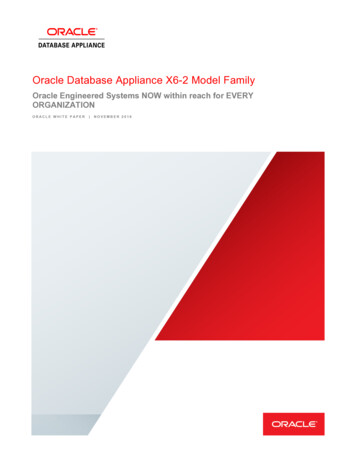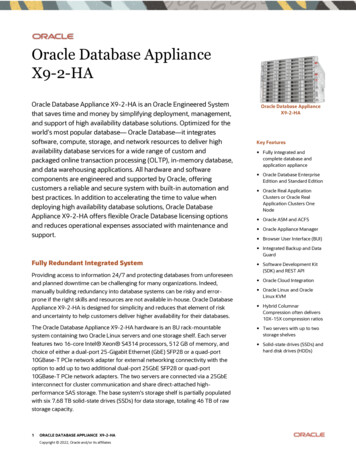
Transcription
Data SheetOracle Database ApplianceX9-2-HAOracle Database Appliance X9-2-HA is an Oracle Engineered Systemthat saves time and money by simplifying deployment, management,and support of high availability database solutions. Optimized for theworld’s most popular database— Oracle Database—it integratessoftware, compute, storage, and network resources to deliver highavailability database services for a wide range of custom andpackaged online transaction processing (OLTP), in-memory database,and data warehousing applications. All hardware and softwarecomponents are engineered and supported by Oracle, offeringcustomers a reliable and secure system with built-in automation andbest practices. In addition to accelerating the time to value whendeploying high availability database solutions, Oracle DatabaseAppliance X9-2-HA offers flexible Oracle Database licensing optionsand reduces operational expenses associated with maintenance andsupport.Oracle Database ApplianceX9-2-HAKey Features Fully integrated andcomplete database andapplication appliance Oracle Database EnterpriseEdition and Standard Edition Oracle Real ApplicationClusters or Oracle RealApplication Clusters OneNode Oracle ASM and ACFS Oracle Appliance Manager Browser User Interface (BUI) Integrated Backup and DataGuardFully Redundant Integrated SystemProviding access to information 24/7 and protecting databases from unforeseenand planned downtime can be challenging for many organizations. Indeed,manually building redundancy into database systems can be risky and errorprone if the right skills and resources are not available in-house. Oracle DatabaseAppliance X9-2-HA is designed for simplicity and reduces that element of riskand uncertainty to help customers deliver higher availability for their databases.The Oracle Database Appliance X9-2-HA hardware is an 8U rack-mountablesystem containing two Oracle Linux servers and one storage shelf. Each serverfeatures two 16-core Intel Xeon S4314 processors, 512 GB of memory, andchoice of either a dual-port 25-Gigabit Ethernet (GbE) SFP28 or a quad-port10GBase-T PCIe network adapter for external networking connectivity with theoption to add up to two additional dual-port 25GbE SFP28 or quad-port10GBase-T PCIe network adapters. The two servers are connected via a 25GbEinterconnect for cluster communication and share direct-attached highperformance SAS storage. The base system's storage shelf is partially populatedwith six 7.68 TB solid-state drives (SSDs) for data storage, totaling 46 TB of rawstorage capacity.1ORACLE DATABASE APPLIANCE X9-2-HACopyright 2022, Oracle and/or its affiliates Software Development Kit(SDK) and REST API Oracle Cloud Integration Oracle Linux and OracleLinux KVM Hybrid ColumnarCompression often delivers10X-15X compression ratios Two servers with up to twostorage shelves Solid-state drives (SSDs) andhard disk drives (HDDs)
Oracle Database Appliance X9-2-HA runs Oracle Database Enterprise Edition orOracle Database Standard Edition. It offers customers the option of runningsingle-instance databases or clustered databases utilizing Oracle RealApplication Clusters (Oracle RAC) or Oracle RAC One Node for "active-active" or"active-passive" database server failover. Oracle Data Guard is integrated withthe appliance to simplify standby databases' configuration for disaster recovery.Optional Storage ExpansionOracle Database Appliance X9-2-HA offers the flexibility to expand the storageshelf that comes with the base system by adding up to eighteen additional SSDsor hard disk drives (HDDs) for data storage. A fully populated storage shelfcontains either twenty-four SSDs or six SSDs and eighteen HDDs for datastorage, for a total of 184 TB SSD or 46 TB SSD and 324 TB HDD raw storagecapacity, respectively. Customers can also optionally add a second storage shelfto double the storage capacity of the system. Also, external NFS storage issupported for online backups, data staging, or other database files.Ease of Deployment, Management, and SupportTo help customers quickly deploy and manage their databases, Oracle DatabaseAppliance comes with Appliance Manager software to simplify the system'sadministration and diagnosis. The Appliance Manager feature dramaticallysimplifies the deployment process and ensures that the system and databaseconfiguration adhere to Oracle's best practices. The browser user interfacequickly gathers all the configuration parameters to streamline both system anddatabase provisioning with a few easy steps. The Appliance Manager alsodrastically simplifies maintenance by patching the entire appliance, including allfirmware and software, using an Oracle-tested patch bundle explicitlyengineered for the appliance. Simply select the appropriate patch bundle in thebrowser user interface to validate it and update the entire system. Databasebackup and recovery are integrated into the Appliance Manager to backuplocally, external storage, or the Oracle Cloud directly through the browser userinterface. The Appliance Manager also tracks system and database informationand displays the information in the browser user interface. Built-in diagnosticscontinually monitor the appliance and detect component failures, configurationissues, and deviations from best practices. In addition, Oracle DatabaseAppliance Auto Service Request (ASR) feature can automatically log servicerequests with Oracle Support to help speed resolution of issues.Flexible Oracle Database Software LicensingOracle Database Appliance X9-2-HA supports both Oracle Database EnterpriseEdition and Standard Edition. Enterprise deployments that require the enhancedfeature set of Oracle Database Enterprise Edition can take advantage of a uniquecapacity-on-demand database software licensing model to quickly scale utilizedprocessor cores without any hardware upgrades. Customers can deploy thesystem and license as few as 2 processors cores to run their database servers,and incrementally scale up to the maximum of 64 processor cores. This enablescustomers to deliver the performance and reliability that enterprise business2ORACLE DATABASE APPLIANCE X9-2-HACopyright 2022, Oracle and/or its affiliatesKey Benefits World’s #1 database Simple, optimized, andaffordable High availability databasesolutions for a wide range ofapplications Ease of deployment,patching, management, anddiagnostics Simplified backup anddisaster recovery Reduced planned andunplanned downtime Cost-effective consolidationplatform Capacity-on-demandlicensing Rapid provisioning of testand developmentenvironments with databasesnapshots Single-vendor support
users demand, and align software spend with business growth. Smallenterprises, line-of-business departments, and branch office deployments thatdon’t require enterprise class features can license Oracle Database StandardEdition, allowing them to realize the benefits of Oracle Database Appliance toreduce costs and improve productivity.Integrated Virtualization SupportVirtualization provides IT cost savings and better resource utilization throughconsolidation of multiple physical servers as Virtual Machines in an OracleDatabase Appliance. It helps reduce space, power, and cooling for data centersand provides isolation for workloads to improve service quality for applicationsand databases. Oracle Database Appliance supports two types of Kernel-basedVirtual Machines (KVM) that can be quickly deployed using built-in userinterfaces: Application KVM and Database KVM (a.k.a. database system). In anapplication KVM, customers manage the installation and maintenance of theapplication, while in the Database KVM, the Oracle Database Appliance managesthe installation and maintenance of the Oracle Database.KVM database systems enable hard partitioning for Oracle Database licensing,where each KVM database system can have its own CPU pool that isautomatically assigned during KVM database system creation, or share a CPUpool. Oracle Database Appliance simplifies the management of KVM databasesystems with built-in user interfaces. Oracle Database Appliance X9-2-HA alsooffers built-in high availability features, auto-restart, and failover for applicationKVMs.Solution-In-A-Box Through VirtualizationOracle Database Appliance X9-2-HA enables customers and ISVs to quicklydeploy database and application workloads on a single Oracle DatabaseAppliance. Support for virtualization adds additional flexibility to the alreadycomplete and fully integrated database solution by providing isolation betweendatabase and application instances.Customers and ISVs benefit from a complete solution that efficiently utilizesresources and takes advantage of capacity-on-demand licensing for multipleworkloads by leveraging Oracle KVM hard partitioning.ConclusionFor customers seeking a simple, optimized, and affordable database solution,the Oracle Database Appliance X9 model family offers optimized purpose-builthardware and software choices for every organization. The Oracle DatabaseAppliance is engineered across every technology stack level, resulting in easierdeployment and upgrades and more efficient management. With the OracleDatabase Appliance X9 model family, customers can quickly bring new servicesto the market while improving their service levels – adding business value totheir company.To learn more about the Oracle Database Appliance X9 model family, visit:www.oracle.com/oda3ORACLE DATABASE APPLIANCE X9-2-HACopyright 2022, Oracle and/or its affiliates
Oracle Database Appliance X9-2-HA SpecificationsARCHITECTURESystem§ Two 2U X9-2L servers and one 4U DE3-24C storage shelf per system§ Optional second storage shelf may be added for storage expansionProcessor§ Two Intel Xeon processors per server§ Intel Xeon Silver 4314 2.4 GHz, 16 cores, 135 watts, XCC, 24 MB L3 cacheCache§ Level 1: 32 KB instruction and 32 KB data L1 cache per core§ Level 2: 1 MB shared data and instruction L2 cache per core§ Level 3: up to 1.375 MB shared inclusive L3 cache per coreMain Memory§ 512 GB (16 x 32 GB) per server§ Optional memory expansion to 1 TB (32 x 32 GB) per server§ Both servers must contain the same amount of memoryServer Storage§ Two internal 240 GB M.2 SSDs (mirrored) per server for Operating System and Oracle Grid Infrastructure(GI) SoftwareSTORAGE (STORAGE SHELF DE3-24C)HIGH PERFORMANCEUsable Capacity(Double Mirroring)Usable Capacity(Triple Mirroring)Data StorageQuantityRaw CapacityBase System6 x 7.68 TB SSD46 TB17.8 TB11.9 TBPlus 6 SSDs12 x 7.68 TB SSD92 TB35.6 TB23.7 TBPlus 6 SSDs18 x 7.68 TB SSD138 TB53.4 TB35.6 TBFull Shelf24 x 7.68 TB SSD184 TB71.2 TB47.5 TBDouble Shelf48 x 7.68 TB SSD368 TB142.5 TB95.0 TBFull Shelf6 x 7.68 TB SSD46 TB17.8 TB11.9 TB(SSDs Plus HDDs)18 x 18 TB HDD324 TB125.2 TB83.5 TBDouble Shelf12 x 7.68 TB SSD92 TB35.6 TB23.7 TB(SSDs Plus HDDs)36 x 18 TB HDD648 TB250.5 TB167.0 TBHIGH CAPACITY Base system storage shelf contains six solid-state drives (SSDs)Additional SSDs must be added in groups of sixHard-disk drives (HDDs) must be added in groups of eighteen to fully populate the entire storage shelfOptional second storage shelf for storage expansion must be fully populated.The raw storage capacity is based on storage industry conventions where 1 TB equals 1,0004 bytes.The usable storage capacity is based on operating system conventions where 1 TB equals 1,0244 bytes and accounts for 15% reserved space required torebuild full redundancy in case of disk failure.I NTERFACESStandard I/O 4One 100Mb/1Gb ethernet port and one serial RJ45 port per serverOne USB 3.0 ports (one rear) per serverPCIe slot 1: dual-port 25 GbE (SFP28) card (Interconnect)PCIe slot 2: dual-port external SAS HBAPCIe slot 4: Choice of quad-port 10GBase-T card or dual-port 10/25 GbE (SFP28) card (Optional)PCIe slot 6: Choice of quad-port 10GBase-T card or dual-port 10/25 GbE (SFP28) cardPCIe slot 8: Choice of quad-port 10GBase-T card or dual-port 10/25 GbE (SFP28) card (Optional)PCIe slot 9: dual-port external SAS HBANote: No additional PCIe cards can be added in the non-mentioned slotsORACLE DATABASE APPLIANCE X9-2-HACopyright 2022, Oracle and/or its affiliates
SYSTEMS MANAGEMENTInterfacesService ProcessorMonitoring§ Dedicated 10/100/1000 M Base-T network management port§ In-band, out-of-band, and side-band network management access§ RJ45 serial management portOracle Integrated Lights Out Manager (Oracle ILOM) provides:§§§§§§§Remote keyboard, video, and mouse redirectionFull remote management through command-line, IPMI, and browser interfacesRemote media capability (USB, DVD, CD, and ISO image)Advanced power management and monitoringActive Directory, LDAP, and RADIUS supportDual Oracle ILOM flashDirect virtual media redirection§§§§Comprehensive fault detection and notificationIn-band, out-of-band, and side-band SNMP monitoring v3Syslog and SMTP alertsAutomatic creation of a service request for key hardware faults with Oracle auto service request (ASR)SOFTWAREOracle Software§ Oracle Linux (Pre-Installed)§ Oracle Linux KVM (Pre-Installed and optional to use)§ Appliance Manager (Pre-Installed)Oracle Database Software(Licensed Separately)§ Choice of Oracle Database software, depending on the desired level of availability:- Oracle Database 21c Enterprise Edition, Standard Edition 2- Oracle Database 19c Enterprise Edition, Standard Edition 2- Oracle Database 12c Enterprise Edition Release 1, Release 2, Standard Edition 2- Oracle Real Application Clusters One Node- Oracle Real Application Clusters§ Support for:- Oracle Database options- Oracle Enterprise Manager Management Packs for Oracle Database Enterprise EditionCapacity-On-DemandSoftware Licensing for OracleDatabase Enterprise Edition§ Enable and license 2, 4, 6, 8, 10, 12, 16, 20, 24, 28, or 32 cores per server§ Note: Both servers must have the same number of cores enabled, however, it is possible to license softwarefor only one of the servers or both servers, depending on the high availability requirementsORACLE DATABASE APPLIANCE SOFTWARE FEATURESMANAGEABILITY5Appliance ManagerThe software interface for the Oracle Database Appliance simplifies the deployment, management, andsupport of your Oracle Database Appliance.Management InterfacesCommand Line interface (CLI), Web Browser Interface (BUI), and REST/API.Database TemplatesPre-defined (based on Oracle best practices database parameters) database templates sized for bestperformance to satisfy various workloads for OLTP, DSS, and In-Memory.Capacity-on-DemandLicensingA database licensing capability to enable only the processor cores (two minimum) required and to easilyscale to a higher number as business needs change.Single Patch for Entire StackProvides a single patch for the entire stack that includes the latest Oracle Database RU, Oracle GI, OracleLinux, Hardware firmware updates, etc. Applying Out-of-Cycle Database Patches is also supported.Integrated KVM VirtualizationLinux kernel-based virtual machine (KVM) enables virtualization for Oracle Database or Applications.Supports Hard Partitioning for Oracle Database licensing.CPU PoolsEnable management of CPU resources, providing QoS (Quality of Service) by guaranteeing dedicated CPUresources for Databases and VMs. (note: CPU pools cannot be used for Oracle Database licensing)Automated ServiceabilityThrough Oracle Auto Service Request (ASR), problems are resolved faster with ASR, which automaticallyopens service requests for your Oracle Database Appliance when specific faults occur.ORACLE DATABASE APPLIANCE X9-2-HACopyright 2022, Oracle and/or its affiliates
Automated MonitoringThe ODA Hardware Monitoring Tool displays the status of different hardware components in OracleDatabase Appliance server. It reports information only for the node on which you run the command.Automated DiagnosticsOracle Database Appliance uses Oracle Autonomous Health Framework, which collects and analyzesdiagnostic data, and proactively identifies issues before they affect the health of your system.ODA Software DevelopmentKit (SDK)The ODA SDK publicly exposes the ODA REST and Java API to invoke ODA database servicesprogrammatically.Oracle Enterprise Manager(OEM) Plug-InThe ODA EM Plug-In supports detailed monitoring of one or multiple Oracle Database Appliances andprovides actionable component level analytics across an ODA groupHIGH AVAILABILITYAutomated Deployment RACIntegrated Oracle RAC (Real Application Cluster) configuration to deploy a RAC system in 90 minutes orlessIntegrated Standard EditionHigh Availability (SEHA)Standard Edition High Availability (SEHA) uses Oracle Grid Infrastructure to provide cluster-based failoverfor Oracle Database 19c Standard Edition 2 databases (with ODA HA model only)DATA PROTECTIONAutomated Database Backup(including to Cloud)Integrated RMAN for simple backup operation of Oracle Databases to Oracle Cloud Infrastructure ObjectStorage or Internal FRA/ External FRA. Restore can be done to different levels (latest, PITR, SCN, etc.)Integrated Data GuardConfigurationOracle Database Appliance provides client interface through ODACLI commands for easy configurationand management of Oracle Data Guard for high availability, data protection, and disaster recovery.Integrated Database SecurityAssessment Tool (DBSAT)Run DBSAT reports directly from the Browser User Interface (BUI). The Oracle Database SecurityAssessment Tool (DBSAT) helps identify areas where your database configuration, operation, orimplementation introduces risks and recommends changes and controls to mitigate those risks.System Disk BackupUse Oracle Database Appliance Backup and Recovery (ODABR) to back up the system disks to ensure easyrestore if the patching operation fails. ODABR restores the system disk to pre-patching state.Other Data ProtectionFeatures Prioritize Recovery of Critical Database Files Automatic Repair of Corrupt Disk DataDATA MANAGEMENTBuilt-in Storage ManagementIntegrated ASM for simplified storage management, where the user only selects a few options, and theAppliance Manager automatically configures ASMIntegrated Database ClonesRapid and efficient database copies using integrated ACFS Snapshots to provision database environmentsfor development and testing of applications.Hybrid ColumnarCompression (HCC) SupportEnables the highest levels of data compression possible with Oracle databases, often delivering 10X-15Xcompression ratios. It provides substantial cost-savings and performance improvements due to reducedI/O, especially for analytic workloads. (Requires ODA SW 18.8 or higher, and Oracle EE license).SECURITY AND COMPLIANCE6Hardening Installed packages are trimmed to a minimum, so that unnecessary packages are not installedOnly essential services are enabled on the Oracle Database Appliance nodesOperating system users are auditedSecure configurations for NTP, SSH, and other servicesSecurity Capabilities Isolation policiesControlled access to dataCryptographic servicesMonitoring and auditingUnified Auditing for Oracle databaseOracle Integrated Lights Out Manager (ILOM) for secure managementEncryptionIntegrated TDE support for database lifecycle management, including backup and iRestore(Oracle Database Transparent Data Encryption [TDE] requires Advanced Security Option license)Multi-User AccessCreate multiple users with different roles that restrict them from accessing resources created by otherusers and restrict the set of operations they can perform.Compliance FIPS 140-2 Level one compliant STIG (Security Technical Guide) security audit script Secure erase drivesORACLE DATABASE APPLIANCE X9-2-HACopyright 2022, Oracle and/or its affiliates
Adaptive Classification andRedaction (ACR)Enables the sanitization of sensitive diagnostic data, such as Host names, IP and MAC addresses, OracleDatabase names, tablespace names, user data that may leak into redo and block dumps in trace files, etc.Some features are specific to Oracle Database Enterprise Edition (Data Guard, TDE, etc.) and need to be licensed appropriately. Others areincluded with either the Oracle Database Enterprise Edition (i.e., HCC) or Standard Edition (i.e., SEHA) licensing. Talk to your Oracle Databasesales representative for details.ENVIRONMENTALEnvironmental Temperature,Humidity, Altitude§ Operating temperature: 5 C to 35 C (41 F to 95 F)§ Nonoperating temperature: -40 C to 70 C (-40 F to 158 F)§ Operating relative humidity: 10% to 90%, noncondensing§ Nonoperating relative humidity: Up to 93%, noncondensing§ Operating altitude: Maximum ambient operating temperature is derated by 1 C per 300 m of elevationbeyond 900 m, up to a maximum altitude of 3000 m (except in China where regulations may limitinstallations to a maximum altitude of 6,560 feet or 2,000 m)§ Nonoperating altitude: up to 39,370 feet (12,000 m)§ 8.1 Bels A-weighted Operating, and 5.8 Bels A-weighted Idling (measured Sound Power).Check your local regulations for noise level exposure limits in the workplace that apply to your installationof Oracle equipment and appropriate use of personal protection equipment.POWER AND THERMALPower§ Two 1,200 watt hot-swappable and redundant power supplies, rated 96% efficiency- Rated line voltage: 100 to 240 VAC- Rated input current 100 to 127 VAC 10 A and 200 to 240 VAC 7 A§ Two 580 Watt hot-swappable, redundant power supplies per storage shelf, rated 88% efficiency- Rated line voltage: 100 to 240 VAC- Rated input current: 100 VAC 8A and 240 VAC 3ATwo Server in HA config(Max Memory)§ Maximum power usage: 1,120W, 3,822 BTU/Hr§ Active Idle power usage: 516W, 1,760 BTU/HrStorage Shelf(DE3-24C: 24 x 7.68 TB SSDs)§ Maximum power usage: 449W, 1,529 BTU/Hr§ Typical power usage: 276W, 940 BTU/HrStorage Shelf(DE3-24C: 6 x 7.68 TB SSDs,18 x 18 TB HDDs)§ Maximum power usage: 434W, 1,479 BTU/Hr§ Typical power usage: 271W, 925 BTU/HrPHYSICAL SPECIFICATIONSHeight: 86.9 mm (3.4 in.) per server; 175 mm (6.9 in.) per storage shelfWidth: 445.0 mm (17.5 in.) per server; 483 mm (19.0 in.) per storage shelfDepth: 759.4 mm (29.9 in.) per server; 630 mm (24.8 in.) per storage shelfWeight: 28.6 kg (63 lb.) per server; 38 kg (84 lbs) per storage shelfDimensions and Weight§§§§Included Installation Kits§ Tool-less rack mounting slide rail kit§ Cable management armREGULATIONS AND TL (North America Safety)CE (European Union)International CB SchemeBIS (India)BSMI (Taiwan)CCC (PRC)EAC (EAEU including Russia)KC (Korea)RCM (Australia)ORACLE DATABASE APPLIANCE X9-2-HACopyright 2022, Oracle and/or its affiliates
§ VCCI (Japan)§ UKCA (United Kingdom)1 All standards and certifications referenced are to the latest official version. For additional detail, please contact your sales representative. Other countryregulations/certifications may apply.For regulatory compliance information, please consult the “Safety and Compliance Guide” available in the product’s documentation library athttps://docs.oracle.com.Connect with usCall 1.800.ORACLE1 or visit oracle.com. Outside North America, find your local office at: acleCopyright 2022, Oracle and/or its affiliates. All rights reserved. This document isprovided for information purposes only, and the contents hereof are subject to changewithout notice. This document is not warranted to be error-free, nor subject to any otherwarranties or conditions, whether expressed orally or implied in law, including impliedwarranties and conditions of merchantability or fitness for a particular purpose. Wespecifically disclaim any liability with respect to this document, and no contractualobligations are formed either directly or indirectly by this document. This documentmay not be reproduced or transmitted in any form or by any means, electronic ormechanical, for any purpose, without our prior written permission.8ORACLE DATABASE APPLIANCE X9-2-HACopyright 2022, Oracle and/or its affiliatestwitter.com/oracleOracle and Java are registered trademarks of Oracle and/or its affiliates. Other names may betrademarks of their respective owners.Intel and Intel Xeon are trademarks or registered trademarks of Intel Corporation. All SPARCtrademarks are used under license and are trademarks or registered trademarks of SPARCInternational, Inc. AMD, Opteron, the AMD logo, and the AMD Opteron logo are trademarks orregistered trademarks of Advanced Micro Devices. UNIX is a registered trademark of The OpenGroup. June, 2022
KVM database systems enable hard partitioning for Oracle Database licensing, where each KVM database system can have its own CPU pool that is automatically assigned during KVM database system creation, or sh are a CPU pool. Oracle Database Appliance simplif ies the management of KVM database systems with built-in user interfaces.
